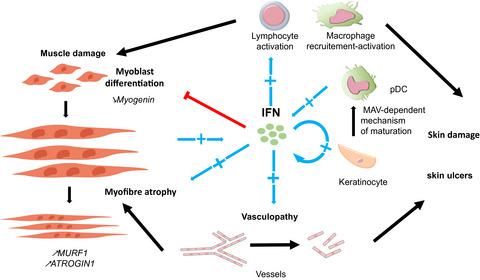当前位置:
X-MOL 学术
›
Brain Pathol.
›
论文详情
Our official English website, www.x-mol.net, welcomes your feedback! (Note: you will need to create a separate account there.)
The role of interferons type I, II and III in myositis: A review
Brain Pathology ( IF 6.4 ) Pub Date : 2021-05-27 , DOI: 10.1111/bpa.12955 Loïs Bolko 1 , Wei Jiang 2, 3 , Nozomu Tawara 2, 3 , Océane Landon-Cardinal 4, 5 , Céline Anquetil 2, 3 , Olivier Benveniste 2, 3 , Yves Allenbach 2, 3
Brain Pathology ( IF 6.4 ) Pub Date : 2021-05-27 , DOI: 10.1111/bpa.12955 Loïs Bolko 1 , Wei Jiang 2, 3 , Nozomu Tawara 2, 3 , Océane Landon-Cardinal 4, 5 , Céline Anquetil 2, 3 , Olivier Benveniste 2, 3 , Yves Allenbach 2, 3
Affiliation

|
The classification of idiopathic inflammatory myopathies (IIM) is based on clinical, serological and histological criteria. The identification of myositis-specific antibodies has helped to define more homogeneous groups of myositis into four dominant subsets: dermatomyositis (DM), antisynthetase syndrome (ASyS), sporadic inclusion body myositis (sIBM) and immune-mediated necrotising myopathy (IMNM). sIBM and IMNM patients present predominantly with muscle involvement, whereas DM and ASyS patients present additionally with other extramuscular features, such as skin, lung and joints manifestations. Moreover, the pathophysiological mechanisms are distinct between each myositis subsets. Recently, interferon (IFN) pathways have been identified as key players implicated in the pathophysiology of myositis. In DM, the key role of IFN, especially type I IFN, has been supported by the identification of an IFN signature in muscle, blood and skin of DM patients. In addition, DM-specific antibodies are targeting antigens involved in the IFN signalling pathways. The pathogenicity of type I IFN has been demonstrated by the identification of mutations in the IFN pathways leading to genetic diseases, the monogenic interferonopathies. This constitutive activation of IFN signalling pathways induces systemic manifestations such as interstitial lung disease, myositis and skin rashes. Since DM patients share similar features in the context of an acquired activation of the IFN signalling pathways, we may extend underlying concepts of monogenic diseases to acquired interferonopathy such as DM. Conversely, in ASyS, available data suggest a role of type II IFN in blood, muscle and lung. Indeed, transcriptomic analyses highlighted a type II IFN gene expression in ASyS muscle tissue. In sIBM, type II IFN appears to be an important cytokine involved in muscle inflammation mechanisms and potentially linked to myodegenerative features. For IMNM, currently published data are scarce, suggesting a minor implication of type II IFN. This review highlights the involvement of different IFN subtypes and their specific molecular mechanisms in each myositis subset.
中文翻译:

I、II 和 III 型干扰素在肌炎中的作用:综述
特发性炎症性肌病 (IIM) 的分类基于临床、血清学和组织学标准。肌炎特异性抗体的鉴定有助于将更同质的肌炎组定义为四个主要亚组:皮肌炎 (DM)、抗合成酶综合征 (ASyS)、散发性包涵体肌炎 (sIBM) 和免疫介导的坏死性肌病 (IMNM)。sIBM 和 IMNM 患者主要表现为肌肉受累,而 DM 和 AyS 患者还表现为其他肌肉外特征,如皮肤、肺和关节表现。此外,每个肌炎亚群之间的病理生理机制是不同的。最近,干扰素 (IFN) 途径已被确定为与肌炎病理生理学有关的关键因素。在 DM 中,IFN 的关键作用,尤其是 I 型 IFN,已通过在 DM 患者的肌肉、血液和皮肤中识别出 IFN 特征得到支持。此外,DM 特异性抗体靶向参与 IFN 信号通路的抗原。I 型 IFN 的致病性已通过识别导致遗传疾病、单基因干扰素病的 IFN 途径中的突变来证明。这种 IFN 信号通路的组成性激活诱导全身性表现,例如间质性肺病、肌炎和皮疹。由于 DM 患者在获得性 IFN 信号通路激活的背景下具有相似的特征,我们可以将单基因疾病的基本概念扩展到获得性干扰素病,例如 DM。相反,在 ASyS 中,现有数据表明 II 型 IFN 在血液、肌肉和肺中的作用。的确,转录组学分析强调了 ASys 肌肉组织中的 II 型 IFN 基因表达。在 sIBM 中,II 型 IFN 似乎是参与肌肉炎症机制的重要细胞因子,并可能与肌退行性特征有关。对于 IMNM,目前公布的数据很少,这表明 II 型干扰素的影响很小。本综述强调了不同 IFN 亚型的参与及其在每个肌炎亚群中的特定分子机制。
更新日期:2021-05-27
中文翻译:

I、II 和 III 型干扰素在肌炎中的作用:综述
特发性炎症性肌病 (IIM) 的分类基于临床、血清学和组织学标准。肌炎特异性抗体的鉴定有助于将更同质的肌炎组定义为四个主要亚组:皮肌炎 (DM)、抗合成酶综合征 (ASyS)、散发性包涵体肌炎 (sIBM) 和免疫介导的坏死性肌病 (IMNM)。sIBM 和 IMNM 患者主要表现为肌肉受累,而 DM 和 AyS 患者还表现为其他肌肉外特征,如皮肤、肺和关节表现。此外,每个肌炎亚群之间的病理生理机制是不同的。最近,干扰素 (IFN) 途径已被确定为与肌炎病理生理学有关的关键因素。在 DM 中,IFN 的关键作用,尤其是 I 型 IFN,已通过在 DM 患者的肌肉、血液和皮肤中识别出 IFN 特征得到支持。此外,DM 特异性抗体靶向参与 IFN 信号通路的抗原。I 型 IFN 的致病性已通过识别导致遗传疾病、单基因干扰素病的 IFN 途径中的突变来证明。这种 IFN 信号通路的组成性激活诱导全身性表现,例如间质性肺病、肌炎和皮疹。由于 DM 患者在获得性 IFN 信号通路激活的背景下具有相似的特征,我们可以将单基因疾病的基本概念扩展到获得性干扰素病,例如 DM。相反,在 ASyS 中,现有数据表明 II 型 IFN 在血液、肌肉和肺中的作用。的确,转录组学分析强调了 ASys 肌肉组织中的 II 型 IFN 基因表达。在 sIBM 中,II 型 IFN 似乎是参与肌肉炎症机制的重要细胞因子,并可能与肌退行性特征有关。对于 IMNM,目前公布的数据很少,这表明 II 型干扰素的影响很小。本综述强调了不同 IFN 亚型的参与及其在每个肌炎亚群中的特定分子机制。


























 京公网安备 11010802027423号
京公网安备 11010802027423号